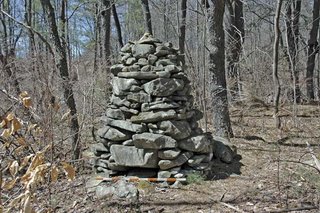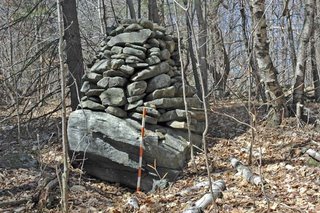Last year around this time, I spent a day exploring parts of  In the morning, I was taken to a side street out of town, where I was shown a very small chamber built into a slope -- certainly too small for a person. On top of the lintel, in the center, was a piece of hematite, which is pure iron oxide and very heavy. Was this placement purely accidental? I don’t think so. Hematite is a source of red ochre, which is often associated with ancient burials.
In the morning, I was taken to a side street out of town, where I was shown a very small chamber built into a slope -- certainly too small for a person. On top of the lintel, in the center, was a piece of hematite, which is pure iron oxide and very heavy. Was this placement purely accidental? I don’t think so. Hematite is a source of red ochre, which is often associated with ancient burials.
Later that morning, I was shown a huge cone cairn, probably 7’ high, in the middle of a trail. At the base, on one side, was a tiny chamber, and it was topped with a piece of quartz. I had seen a chamber built into a wall before (at
At the base, on one side, was a tiny chamber, and it was topped with a piece of quartz. I had seen a chamber built into a wall before (at 
In the afternoon we visited a cairn site on a ridge outside of town. It was the high point of the trip, and rather overwhelming. There were several large platform 
 Then there were a number of very elaborate
Then there were a number of very elaborate 
 This reminded me somewhat of the chambers I saw in
This reminded me somewhat of the chambers I saw in
 Lastly, was a very nice boulder fill, of a type that I have seen numerous times, but not like this.
Lastly, was a very nice boulder fill, of a type that I have seen numerous times, but not like this.
3 comments :
This is very thought provoking. First about Hematite included in a stone chamber. We know Indians used Hematite in burials but by "Ancient burials" did you mean anyone else? I ask this because the example helps steer attention away from diffusion and towards recognizing Native Americans as the originators of the stonework. Second about small chambers and rock piles, this is enough examples that we really have to take seriously the question of what goes into the chamber? An offering? I don't know if it is relevant but there seems to be another small recess in the platform pile with the pointer - and the pointer is lined up with the shadow of the recess.
One final comment is that several of these cairns, as rock piles, seem very new and in very good shape. So I wonder if someone is maintaining them currently?
Red ochre has been used in ancient burial practices both in Europe and North America, but my emphasis in writing about this piece of hematite was on American Indian uses of this stone. In Europe, if my memory is correct, red ochre was used in burials thousands of years ago, but the small chamber in Washington, MA, is hardly that old, so my conclusion is that its presence here is probably hundreds of years old, not thousands. A good layer of soil was impacted around the stone when I lifted it -- and placed it back exactly where it was. I do believe the hematite helps to identify this as an Indian chamber rather than a Colonial one.
I didn't get the sense that the cairns were new, or had been recently maintained. All had a good covering of lichen on them. Having seen so many cairns from VT to MA and beyond, all well covered with lichen, and recognizing that some of the Inuksuits in the Arctic are thousands of years old, yet are in excellent condition, I have to say the Washington cairns are probably very, very old. Also, the chances of damage by falling trees is probably very small, given that most trees have a life span of, say, 150 years, if not felled beforehand by winds, disease, or loggers. Also, a huge tree landed on a platform cairn in S. Newfane, VT, without causing any damage.
Nice site and photos. It's fascinating to learn about these different sites in different places, and see the similarities and differences.
Here's the url for a picture of the Scotrun wall chamber I posted a while back:
http://photos1.blogger.com/blogger/2715/2502/1600/SR%20chamber.0.jpg
Post a Comment